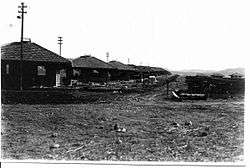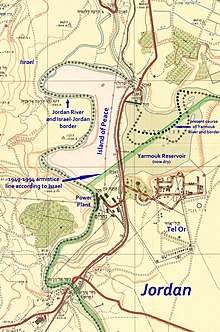Tel Or

Tel Or (Hebrew: תל אור - Hill of Light) was a company town in Transjordan which housed the predominantly-Jewish workers at the Naharayim hydroelectric power plant on the Transjordanian side of the Palestine-Transjordan border.[1] The town was settled in 1930 (officially founded in 1932) and lasted until its depopulation in 1948 during the Arab-Israeli War, when it was overrun by Iraqi and Transjordanian forces.
History

In 1928 the engineer Pinhas Rotenberg began the construction of the Naharayim hydroelectric power plant on the territory of Transjordanian Emirate. The plant was constructed at the point of intersection of the Yarmouk and the Lower Jordan river, and its purpose was to utilize the flow of water in order to generate electricity for towns and cities of Mandatory Palestine.
In the vicinity of the power plant, the village of Tel Or was built, being the only Jewish village in Transjordan at the time. Tel Or was designated for residence of the permanent employees of the power plant and their families, aiming to create an agricultural village at the Eastern border of the Land of Israel. Employees of the power station also farmed thousands of dunams of land and sold some of the produce at a company workers’ supermarket in Haifa. Due to its relative isolation and despite the limited number of resident families, the village included a clinic, a kindergarten, and even a school, established by Yosef Hanani for the children of employees.
During the 1947-8 Civil War in Mandatory Palestine, because of the difficult security situation, the Naharayim power plant ceased operation for the first time in 15 years. In violation of a November 1947 agreement between Meir and Abdullah, the Arab Legion's 4th Battalion launched a mortar and artillery attack on the Naharayim police fort and Kibbutz Gesher on April 27–29, 1948. On the evening of April 27, the Legion began shelling the fort and kibbutz, stepping up the attack the following day. Many of the kibbutz buildings were destroyed.[2] On the morning of April 29, a Legion officer demanded the evacuation of the Gesher police fort, but was turned down. After protests to the British Mandate administration, the shelling was halted, and Abdullah was reprimanded for "aggression against Palestine territory."[2] The families of the employees were evacuated in April 1948, leaving behind only workers with Jordanian ID cards. Following a prolonged battle between Yishuv forces and the Transjordanian Arab Legion in the area, the residents of Tel Or were given an ultimatum to surrender or leave the village. The village of Tel Or was shortly abandoned by the residents, who fled to Yishuv-controlled areas to the West.
An Iraqi brigade invaded at Naharayim area on May 15, 1948, in an unsuccessful attempt to take the Gesher kibbutz and fort.[2] The power plant was occupied and looted by the Iraqi forces. After the Tel Or village and the power plant were overran by the Arab forces they were destroyed. To prevent Iraqi tanks from attacking Jewish villages in the Jordan Valley, the sluice gates of the Degania dam were opened. The rush of water, which deepened the river at this spot, was instrumental in blocking the Iraqi-Jordanian incursion.
The remains of Tel Or are in Jordan not far from the Island of Peace. There is an ongoing project to develop a Jordan River Peace Park, spanning the border with Israel, that will include the site.[3]
References
- ↑ Encyclopedia of Zionism and Israel, ed. Raphael Patai, Herzl Press/McGraw Hill, New York, Vol. 2, p.818
- 1 2 3 Morris, B. (2003). The Road to Jerusalem: Glubb Pasha, Palestine and the Jews. I. B. Tauris. p. 134. ISBN 9781860649899. Retrieved 2016-09-05.
- ↑ EcoPeace Middle East. "Jordan River Peace Park".